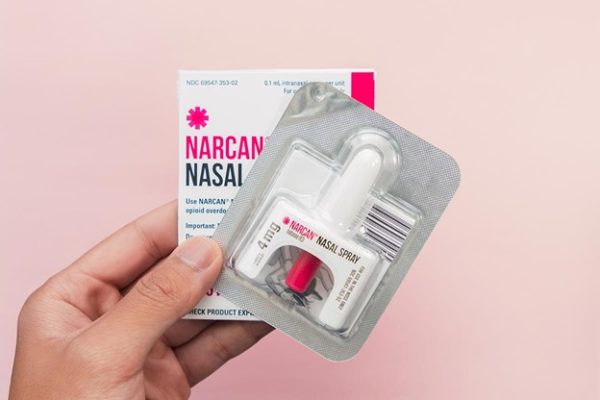Dozens of Nicaraguan Migrants Die from Fentanyl in the USA

HAVANA TIMES – Two milligrams of fentanyl, equivalent to just ten to fifteen grains of salt, is enough to kill a person. Even so, every day more and more people – consciously or not – ingest the so-called “zombie drug”, considered an epidemic that in the last two years has killed more than 140,000 people in the United States.
The epidemic has also reached Nicaraguan migrants in that country. An analysis of CONFIDENCIAL data estimates that in 2023, at least 40 Nicaraguans died from causes related to the consumption of drugs that were laced with fentanyl. Most of them were young people who had migrated not long before.

Fentanyl, which circulates through the streets of the United States, has reached migrants, and is “ending the American dream of many Nicaraguans,” warned the Texas Nicaraguan Community (TNC), at the end of 2023.
TNC confirmed that, as of April 2023, at least six Nicaraguans had died as a consequence, although many other cases were not registered at the request of family members.
CONFIDENCIAL’s estimate is based on the construction and analysis of a registry of 140 Nicaraguan migrant deaths in the United States that occurred in 2023. The deaths were reported in press releases, social networks, TNC publications, and from users seeking funds to repatriate their relatives.
On most occasions, these deaths were attributed to heart attacks – the ultimate cause of death – due to the fear of social stigma towards the migrant community. Many families, who ask for money to repatriate their deceased, fear that people will refuse to support them thinking that “he died because he was a drug addict.” However, the fentanyl epidemic is more complex, and it is a drug that has taken root in the United States.
“Fentanyl is a potent synthetic opioid, up to 50 times stronger than heroin and 100 times stronger than morphine,” states the #APillKills campaign, from the Texas Health and Human Services Commission, where an average of five people die every day from fentanyl overdoses, including accidental poisonings.

Carlos was killed by fentanyl
Carlos, 29 years old, had only spent three months as a migrant in the United States before he died from fentanyl-laced drugs.
The young man was originally from Managua, where he worked in construction. He had a wife and two daughters, ages eight and one. Before leaving, his family said, he had never used drugs.
He was affectionate with his daughters and made sure they had everything they needed, said his wife in an interview to a local media, when they were carrying out a campaign to repatriate his body. More than four thousand kilometers away from them, and depressed by loneliness, he tried drugs.
The day Carlos died, he had called his wife on the phone. He told her that he was drinking alcohol with other migrants, but that he would soon return to his apartment. The next thing she knew, he dropped dead on a New York street. Carlos had taken drugs adulterated with fentanyl. The consumption of these, along with liquor, caused him to have a seizure that prompted him to run out of the apartment and onto the street.
TNC gave the details in a publication that was later removed at the request of family members, which is why CONFIDENCIAL uses a pseudonym to identify him. Likely, the young migrant did not know he was using drugs adulterated with fentanyl. TNC explains that the migrant community is getting fentanyl mixed with other drugs.
Migration stress and drug use
The majority of reported deaths from TNC in 2023 were of men between 20 and 30 years of age. Their youth, difficulties adjusting to a new country, depression, and work burdens are causing many to use drugs, the Nicaraguan NGO said.
At the end of September 2023, the organization surveyed Nicaraguan migrants. Thirty-nine percent of 800 respondents said they were disappointed with their situation in the United States, that they have problems adapting, and have considered returning to Nicaragua.
Migrants tend to suffer from “migratory stress,” anxiety, and depression due to the fragmentation of their daily lives, according to a study entitled Drug use and responses to migratory stress among Mexican migrants heading to the United States, by Dr. Jorge Luis Arellanez, of the Universidad Veracruzana.
Depending on people’s resources and strategies, there may be a greater or lesser level of adjustment, the specialist adds. Some migrants will be able to integrate and others who have fewer resources will face their emotional discomfort with “the abuse of alcoholic beverages, the consumption of high amounts of tobacco and even experimentation with illicit drugs.”

TNC: 152 Nicaraguan migrants dead in 2023
In 2023, 152 Nicaraguan migrants died in the United States, according to a count published by the Texas Nicaraguan Community.
The database that CONFIDENCIAL constructed listed 140 Nicaraguan migrants who died from different causes in 2023, twelve less than those reported by TNC. Of that list of 140, 48 died in traffic accidents and 40 from heart attacks or cardiac arrest, among them several related to the consumption of adulterated drugs. Eleven others were murdered, and ten died of cancer, leukemia, or other diseases. In addition, three died in fires, three from femicides, two from work-related accidents, and one from drowning. The causes of death are unknown for 12.
Of the 140 migrants who died, 35 were between 20 and 29 years of age, and 34 were between 30 and 39. This means that 49% were under 40 years of age. Another 16 (11%) were between 40 and 49 years old. Although there is no detailed information on how long ago they migrated, it is known that 22 of the 140 had migrated less than a year before their death, and 17 had migrated between one to two years prior. Many of them lived in California, Texas, and Florida.
Conditions for most Nicaraguan migrants in the United States are not favorable, according to the results of the TNC survey. Of the 800 migrants who participated, only four out of ten Nicaraguans said that they were “doing well.” The rest said they were not doing well because of unemployment, adjustment problems, and disillusionment upon arrival.
The NGO warned that these conditions have caused many migrants to fall into drug and alcohol problems. Although some of the cases of deceased migrants are often reported on social networks as deaths due to heart attacks, several of these are related to the consumption of drugs adulterated with fentanyl.

What is fentanyl?
Fentanyl is a synthetic opioid 100 times stronger than morphine. Opioids are a class of drugs found naturally in the poppy plant. Some opioids are made directly from the plant. Others, such as fentanyl, are created in laboratories. These are known as synthetic opioids, explains the U.S. National Institute on Drug Abuse.
Fentanyl has its origins in China, where its production was legal until 2017. After its prohibition, Mexican drug traffickers learned how to “cook” it to continue the million-dollar business of distributing it. A “cook” of the Sinaloa Cartel stated, in a report to the Spanish newspaper El País, that he could earn up to 25,000 dollars in a single day. According to estimates by the Drug Enforcement Administration (DEA) – quoted in the same report – fentanyl can generate profits of between US$160,000 and US$640,000 per kilo.
An aggravating condition for the circulation and consumption of fentanyl is that its manufacturing cost is relatively low. In the United States, the Centers for Disease Control and Prevention (CDC) details that sellers make illegal mixtures, so some may not be aware that they are consuming drugs laced with fentanyl, because it cannot be seen, smelled, or tasted.
“It is nearly impossible to tell if drugs were laced with fentanyl unless they test their drugs with fentanyl test strips,” CDC warns.
Like heroin or morphine, fentanyl acts by binding to opioid receptors found in the brain that control pain and emotions.
The “zombie drug” induces “powerful stimulation,” which can lead to brain changes (or neuroadaptations), including “increased tolerance (requiring increasing doses to achieve desired effects), dependence, addiction, and withdrawal symptoms,” according to a scientific report in National Geographic magazine.
“The toxicity and addictive potential of these narcotic compounds exceed those of morphine and heroin,” warns the publication. It adds that fentanyl “is 50 times more potent than heroin, a potency that has made it one of the most prominent and feared synthetic opioids.”

How to identify an overdose and what to do?
The consumption of fentanyl causes extreme euphoria, lethargy, nausea, confusion, sedation, breathing problems, and loss of consciousness. After repeated use, the brain adapts and its sensitivity decreases, increasing dependence, according to the National Institute on Drug Abuse in the United States.
A person who is suffering from a fentanyl overdose tends to present the following symptoms:
- Small, constricted, pinpoint-like pupils.
- Falling asleep or losing consciousness
- Slow, weak or no breathing
- Gagging or gurgling sounds
- Limp body
- Cold or clammy skin
- Spots on the skin (especially on the lips and fingernails)
It is important to identify these symptoms, because the person may survive if given a dose of naloxone, a powerful drug capable of reversing overdoses of heroin, fentanyl, and other opioids, the CDC says.
Naloxone has been proven to restore a person’s breathing, and in the United States, it is allowed for sale without a prescription. It is also available through community programs.
The CDC recommends the purchase of naloxone for the general population because statistics indicate that 40% of overdose deaths occur in front of other people.
The recommendations in the face of drug overdose are:
- Call 911 when identifying symptoms of a person overdosing.
- Administer naloxone.
- Try to keep the person awake and breathing.
- Place the person on his or her side so that he or she does not choke.
- Stay with the person until emergency personnel arrive.
- What to do in case of a drug or fentanyl overdose
Actions to combat fentanyl
Fentanyl use in the United States began to increase in 2016, but record fentanyl deaths skyrocketed in 2021, with 70,601 deaths. The following year there were another 73,798 deaths.
From 2012 to 2023, some 144 399 people died from overdoses of drugs adulterated with fentanyl, 2.5 times the number of people needed to fill Dodger Stadium, the largest capacity baseball stadium in the United States.
On October 5, 2023, the Mexican and U.S. governments signed an agreement to address fentanyl trafficking. U.S. authorities claim that fentanyl is created in clandestine laboratories and trafficked by Mexican cartels.
“The fentanyl that these cartels produce and traffic is the deadliest drug threat the United States has ever faced,” said U.S. Attorney General Merrick Garland.
Mexican authorities have dismantled 37 fentanyl pill manufacturing laboratories since President Manuel Lopez Obrador came to power in 2018, El Pais revealed. However, Mexican authorities and their president claimed until recently that no such drug was produced in their country.
In June 2023, the United States filed charges against four Chinese-based chemical companies and eight Chinese nationals for trafficking precursor chemicals used to create fentanyl.
Several studies reveal that fentanyl overdose deaths are disproportionately affecting minorities in the United States. In New York, the health department reported that there are more deaths among African Americans and Latinos.
A New York Health Department report said that “disparities in deaths by race-ethnicity, age, income, and neighborhood have widened as the magnitude of the overdose crisis has worsened.”
According to provisional figures from the CDC, the United States closed 2023 with a record number of more than 112,000 drug overdose deaths, 70% of which would be related to fentanyl, which has become the leading cause of overdose deaths in major U.S. cities. In the case of Nicaraguan migrants, it is -for now- the second leading cause of death.





